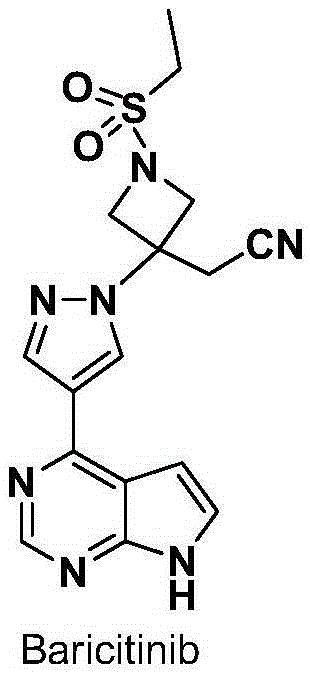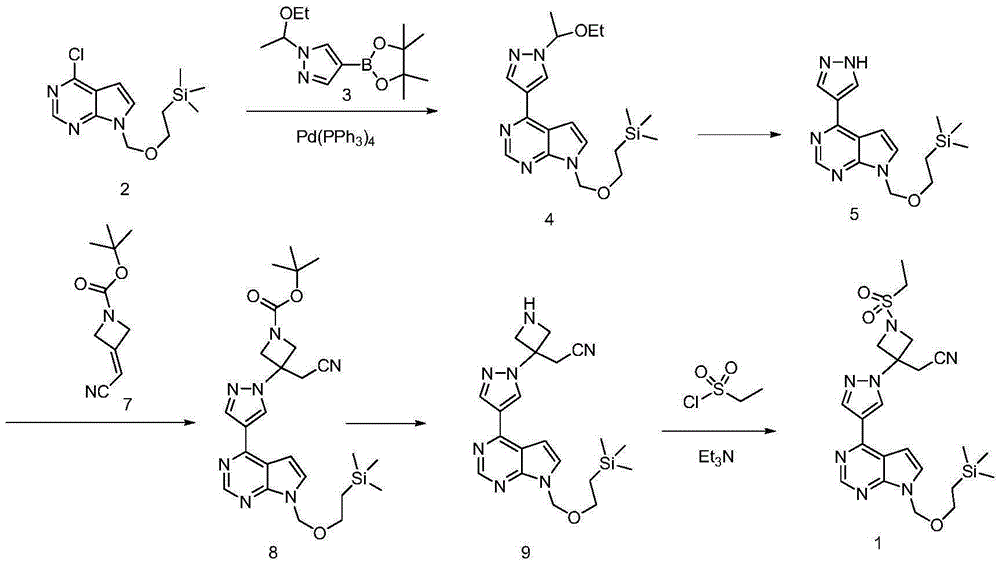Preparation method for Baricitinib intermediate
A compound and alkyl technology, applied in the field of preparation of baricitinib intermediates, can solve the problems of long reaction route, high production cost, discomfort and industrialized production, etc.
- Summary
- Abstract
- Description
- Claims
- Application Information
AI Technical Summary
Problems solved by technology
Method used
Image
Examples
Embodiment 1
[0123] Example 1 Preparation of 4-chloro-7-[(2-(trimethylsilyl)ethoxy)methyl]-7H-pyrrole[2,3-d]pyrimidine (compound of formula IX)
[0124]
[0125] In a 2-liter three-necked flask, add 4-chloropyrrolopyrimidine (280g, 1.83mol) and N,N-dimethylacetamide (500mL), cool down to -10°C, add NaH (84g) three times, and the addition is complete. Keep stirring for 0.5 hours. Add 2-(trimethylsilyl)ethoxymethyl chloride (385mL, 1.98mol). After the addition is complete, react at room temperature for 2 hours, pour the reaction solution into 1L of water, add 500mL of ethyl acetate, stir and extract to separate the ester layer, washed once with 300 mL of saturated sodium chloride, dried over anhydrous sodium sulfate, filtered, and concentrated under reduced pressure to obtain 390 g of a red product with a yield of 75%.
Embodiment 2
[0126] Example 2 2-[1-Ethylsulfonyl-3-[4-(4,4,5,5-tetramethyl-1,3,2-dioxoborolan-2-yl)-1H- Preparation of pyrazol-1-yl]azetidin-3-yl]acetonitrile (compound of formula V)
[0127]
[0128] Add 4-pyrazoleboronic acid pinacol ester (14g, 72.1mmol) to 100mL acetonitrile at room temperature, add 2-[1-(ethylsulfonyl)-3-azetidinylidene]acetonitrile (18g, 96.7mmol ) and DBU (20mL), stirred and reacted at room temperature for 2 hours, added ethyl acetate (500mL) and water (500mL), extracted and separated, the aqueous layer was extracted once with 50mL ethyl acetate, the organic layer was combined, and then washed with 50mL saturated chlorine Wash once with sodium chloride, dry over anhydrous sodium sulfate, filter, and concentrate under reduced pressure to obtain 23 g of a yellow solid. Yield 85%. 1 H-NMR (300MHz, CDCl 3 ), δ (ppm): 1.32 (12H, s, 4×CH 3 ), 1.37~1.41 (3H,t,J=7.4Hz,CH 3 ),3.02~3.09(2H,q,J=7.3Hz,CH 2 ),3.33(2H,s,CNCH 2 ),4.15~4.18(2H,d,J=9.1Hz,NCH 2 ),4.50~4.53...
Embodiment 3
[0129] Example 3 2-[1-Ethylsulfonyl-3-[4-(7-[(2-(trimethylsilyl)ethoxy)methyl]-7H-pyrrolo[2,3-d ]pyrimidin-4-yl)-1H-pyrazol-1-yl]azetidin-3-yl]acetonitrile (compound of formula XI)
[0130]
[0131]4-Chloro-7-[(2-(trimethylsilyl)ethoxy)methyl]-7H-pyrrole[2,3-d]pyrimidine (50g, 0.176mol) and 2-[1 -Ethylsulfonyl-3-[4-(4,4,5,5-tetramethyl-1,3,2-dioxoborolan-2-yl)-1H-pyrazol-1-yl] Azetidin-3-yl]acetonitrile (67g, 0.176mol) was added to a 2L eggplant-shaped bottle, and n-butanol (500mL), potassium carbonate (50g, 0.352mol), and tetrakis(triphenylphosphine)palladium were added successively (0)(Pd(PPh 3 ) 4 , 10g) and water (100mL), heat up to reflux for 2 hours, add 500mL ethyl acetate and 500mL water to the reaction solution, extract and separate the liquid, separate the organic layer, then wash once with 200mL saturated sodium chloride solution, Dry over anhydrous sodium sulfate, filter, and concentrate under reduced pressure to obtain 78 g of light yellow solid with a yiel...
PUM
 Login to View More
Login to View More Abstract
Description
Claims
Application Information
 Login to View More
Login to View More - R&D
- Intellectual Property
- Life Sciences
- Materials
- Tech Scout
- Unparalleled Data Quality
- Higher Quality Content
- 60% Fewer Hallucinations
Browse by: Latest US Patents, China's latest patents, Technical Efficacy Thesaurus, Application Domain, Technology Topic, Popular Technical Reports.
© 2025 PatSnap. All rights reserved.Legal|Privacy policy|Modern Slavery Act Transparency Statement|Sitemap|About US| Contact US: help@patsnap.com



